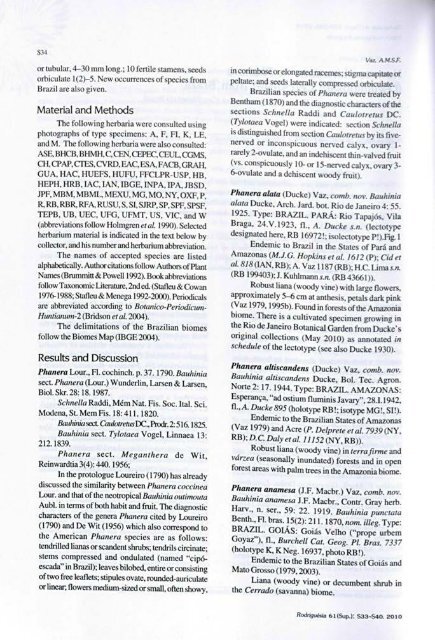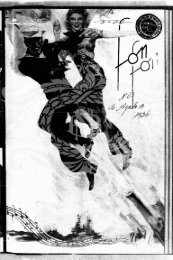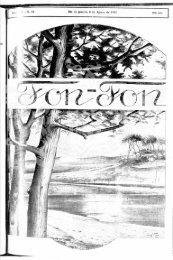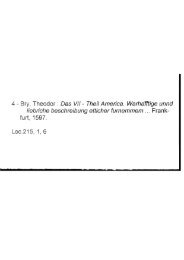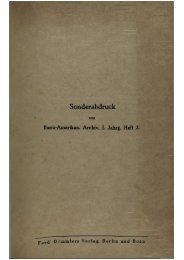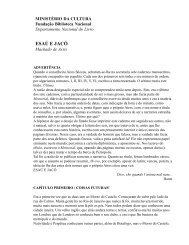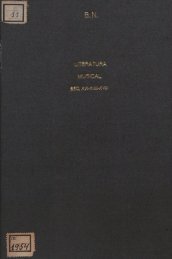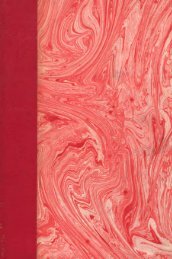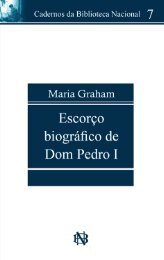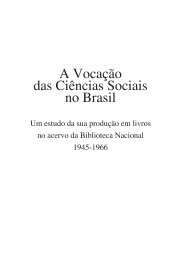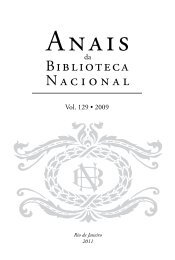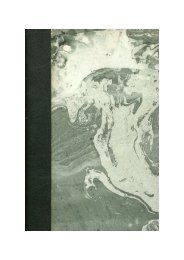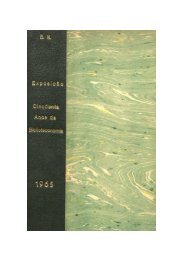vol. 61, Supl. - Fundação Biblioteca Nacional
vol. 61, Supl. - Fundação Biblioteca Nacional
vol. 61, Supl. - Fundação Biblioteca Nacional
Create successful ePaper yourself
Turn your PDF publications into a flip-book with our unique Google optimized e-Paper software.
S34<br />
or tubular, 4-30 mm long.; 10 fertile stamens, seeds<br />
orbiculate 1 (2)-5. New occurrences of species from<br />
Brazil are also given.<br />
Material and Methods<br />
The following herbaria were consulted using<br />
photographs of type specimens: A, F, FI, K, LE,<br />
and M. The following herbaria were also consulted:<br />
ASE, BHCB, BHMH, C, CEN, CEPEC, CEUL, CGMS,<br />
CH, CPAP, CTES, CVRD, EAC, ESA, FACB, GRAH.<br />
GUA, HAC, HUEFS, HUFU, FFCLPR-USP, HB,<br />
HEPH, HRB, IAC, IAN, IBGE, INPA, IPA, JBSD,<br />
JPF, MBM, MBML, MEXU, MG, MO, NY, OXF, P,<br />
R. RB, RBR, RFA, RUSU, S, SI, SJRP, SP, SPF, SPSF,<br />
TEPB, UB, UEC, UFG, UFMT, US, VIC, and W<br />
(abbreviations follow Holmgren et ai. 1990). Selected<br />
herbarium material is indicated in the text below by<br />
collector, and his number and herbarium abbreviation.<br />
The names of accepted species are listed<br />
alphabetically.Authorcitations follow AuthorsofPlant<br />
Names (Brummitt & Powell 1992). Book abbreviations<br />
follow Taxonomic Literature, 2nd ed. (Stafleu & Cowan<br />
1976-1988; Stafleu & Menega 1992-2000). Periodicals<br />
are abbreviated according to Botanico-Periodicum-<br />
Huntianum-2 (Bridson et ai. 2004).<br />
The delimitations of the Brazilian biomes<br />
follow the Biomes Map (IBGE 2004).<br />
Resulte and Discussion<br />
Phanera Lour., Fl. cochinch. p. 37.1790. Bauhinia<br />
sect. Phanera (Lour.) Wunderlin, Larsen & Larsen,<br />
Biol.Skr.28:18.1987.<br />
Schnella Raddi, Mém Nat. Fis. Soe. Ital. Sei.<br />
Modena, St. Mem Fis. 18:411.1820.<br />
BcuMikixctCaubtretusYX2.,Prodr.2:5l6.1825.<br />
Bauhinia sect. Tylotaea Vogel, Linnaea 13:<br />
212.1839.<br />
Phanera sect. Meganthera de Wit,<br />
Reinwardtia3(4):440.1956;<br />
In the protologue Loureiro (1790) has already<br />
discussed the similarity between Phanera coecinea<br />
Lour. and that of the neotropical Bauhinia outimouta<br />
Aubl. in terms of both habit and fruit. The diagnostic<br />
characters of the genera Phanera cited by Loureiro<br />
(1790) and De Wit (1956) which also correspond to<br />
the American Phanera species are as follows:<br />
tendrilled lianas or scandent shrubs; tendrils circinate;<br />
stems compressed and ondulated (named "cipóescada"<br />
in Brazil); leaves bilobed, entire or consisting<br />
of two free leaflets; stipules ovate, rounded-auriculate<br />
or linear; flowers medium-sized or small, often showy.<br />
Vaz. A.M.S.F.<br />
in corimbose or elongated racemes; stigma capitate or<br />
peltate; and seeds laterally compressed orbiculate.<br />
Brazilian species of Phanera were treated by<br />
Bentham (1870) and the diagnostic characters of the<br />
sections Schnella Raddi and Caulotretus DC.<br />
(Tylotaea Vogel) were indicated: section Schnella<br />
is distinguished from section Caulotretus by its fivenerved<br />
or inconspicuous nerved calyx, ovary 1rarely<br />
2-ovulate, and an indehiscent thin-valved fruit<br />
(vs. conspicuously 10- or 15-nerved calyx, ovary 3-<br />
6-ovulate and a dehiscent woody fruit).<br />
Phanera alata (Ducke) Vaz, comb. nov. Bauhinia<br />
alata Ducke, Arch. Jard. bot. Rio de Janeiro 4: 55.<br />
1925. Type: BRAZIL. PARÁ: Rio Tapajós, Vila<br />
Braga, 24.V.1923, fl., A. Ducke s.n. (lectotype<br />
designated here, RB 16972!; isolectotype P!).Fig. 1<br />
Endemic to Brazil in the States of Pará and<br />
Amazonas (M.J.G. Hopkins et ai 1<strong>61</strong>2 (P); Cidet<br />
ai. 818 (IAN, RB); A. Vaz 1187 (RB); H.C. Limais.<br />
(RB 199403);J.Kuhlmanní.«.(RB 436<strong>61</strong>)).<br />
Robust liana (woody vine) with large flowers,<br />
approximately 5-6 cm at anthesis, petals dark pink<br />
(Vaz 1979,1995b). Found in forests of the Amazônia<br />
biome. There is a cultivated specimen growing in<br />
the Rio de Janeiro Botanical Garden from Ducke's<br />
original collections (May 2010) as annotated in<br />
schedule of the lectotype (see also Ducke 1930).<br />
Phanera altiscandens (Ducke) Vaz, comb. nov.<br />
Bauhinia altiscandens Ducke, Boi. Tec. Agron.<br />
Norte 2: 17.1944. Type: BRAZIL. AMAZONAS:<br />
Esperança, "ad ostium fluminis Javary", 28.1.1942,<br />
fl., A Ducke895 (holotype RB!; isotype MG!, SI!).<br />
Endemic to the Brazilian States of Amazonas<br />
(Vaz 1979) and Acre (/>. Delprete et ai. 7939 (NY,<br />
RB); D.C. Dalyetal. 11152 (NY, RB)).<br />
Robust liana (woody vine) in terra firme and<br />
várzea (seasonally inundated) forests and in open<br />
forest áreas with palm trees in the Amazônia biome.<br />
Phanera anamesa (J.F. Macbr.) Vaz, comb. nov.<br />
Bauhinia anamesa J.F. Macbr., Contr. Gray herb.<br />
Harv., n. ser., 59: 22. 1919. Bauhinia punetata<br />
Benth., Fl. bras. 15(2): 211.1870, nom. illeg. Type:<br />
BRAZIL. GOIÁS: Goiás Velho ("prope urbem<br />
Goyaz"), fl., Burchell Cat. Geog. Pi Bras. 7337<br />
(holotype K, K Neg. 16937, photo RB!).<br />
Endemic to the Brazilian States of Goiás and<br />
Mato Grosso (1979,2003).<br />
Liana (woody vine) or decumbent shrub in<br />
the Cerrado (savanna) biome.<br />
Rodrigues* <strong>61</strong>(Sup.): S33-S40. 2010


